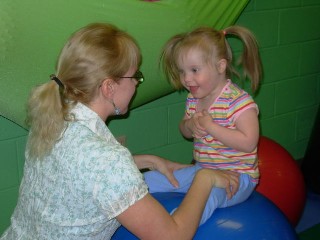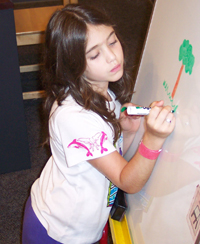
|
Pediatric Occupational, Physical, ABA/Behavioral, Feeding, Speech, and Language Therapies Main Clinic: 931-372-2567 1445 East 10th Street Cookeville, TN 38501 Email: [email protected] HIPAA Secure Email: [email protected] Fax: (931) 372-2572 ABA Clinic: 931-201-9534 400 Dubois Road Cookeville, TN 38501 Email: [email protected] Please call today to get started! Most insurances accepted! |

|
| Who needs therapy? | SE HABLA ESPAÑOL |
Fun Activities

Fun Activities
Children must have stability near the body to have accurate movement away from the body. Make sure that children are stable and supported through the feet and body before they tackle a fine motor task (i.e., feet should not be dangling in the air).
The hand needs to be able to separate the movement side (thumb, index and middle finger) from the stabilization side (ring and little fingers). There are two types of grasps: efficient and inefficient. THE CHILD MAY NOT DEVELOP A MATURE EFFICIENT GRASP UNTIL THEY ARE 5 TO 6 YEARS OLD. When children are introduced to regular size pencils and pens too early, they may have difficulty developing a mature pencil grasp. PRACTICE MAKES PERMANENT! If a child practices with an inefficient grasp, it may become permanent. An efficient grasp the pencil is held between the pads of the thumb and index finger while resting on the middle finger. An acceptable variation of this is when the pencil is held between the pads of the thumb and index/middle fingers while resting on the ring finger. If a child is using an efficient grasp, their thumb and index finger should form a circular shape.
An inefficient grasp can include any of the following: fisted grasp, pencil held between the pads of the thumb and all four fingers, thumb wrapped over the top of the index and middle fingers, thumb tucked under the index finger, the hand held in a thumb down position, index and middle fingers wrapped around the pencil, orthumb pressing the pencil into the side of the index finger (thumb and index do not form a circular shape).
Young children should use short, chubby crayons and markers.
Break long crayons and sidewalk chalk in half to fit little fingers.
Encourage children to hold writing utensils in their fingertips instead of their fists.
Writing, drawing and painting on a vertical surface increases a child's shoulder stability and develops good wrist position fordeveloping a mature pencil grip.
Pre-Writing
When children are introduced to letter formation too early, they tend to "draw" the letters and later have trouble forming the letters correctly. Focus on drawing shapes before you tackle letters. A child who can draw a circle, square, triangle, cross, and diamond will have an easier time learning how to form letters.
Begin by teaching the child the action of the scissors using tweezers/tongs before they begin cutting. The child's hands are usually developmentally ready to operate scissors when they are approximately four years old.
When first introducing scissors, have the child practice opening and closing the scissors. Using the concept of an alligator, the parent verbally instructs the child to imitate opening and closing of the alligator's mouth (the scissor blades). Have beginning cutters cut across small pieces of heavy paper (i.e., magazine inserts, old greeting cards, index cards).
Progression for cutting shapes:
Wide straight lines
Narrow lines
Wide curved lines
Narrow curved lines
Cutting around a corner
Cutting a circular shape
The best scissors have short (3.5 or 4.5 inch), sharp blaes, rounded tips, and small finger loops for the thumb and middle finger to promote better control of finger movements. When teaching children to cut, encourage them to properly hold the scissors with their middle finger and thumb in the finger loops and the index finger supporting the scissor blade. Encourage children to cut with their thumb up by putting a sticker or smiley face on their thumbnail to look at while cutting.
Tape large pieces of paper to the wall, above eye level, for the kids to draw or paint on.
Tape a piece of paper underneath your coffee table and let the kids lie on their backs and color upside down.
Paint a spot on your garage wall with chalkboard paint and let your kids color with sidewalk chalk.
Press play dough onto a vertical surface and let the child hide treasures in it (coins, beads, etc.).
Use a variety of utensils while playing with play dough to improve utensil skills - pizza cutters, plastic knives, cookie cutters.
Make a "cake" out of play dough and let the child place birthday candles in it. With one hand have them pick up the candle and turn it over in the same hand and put the wick end into back into the play dough. See if they can do this without using their other hand, their body, or the table to help them turn the candle over.
Let your kids water the plants outside with a plant sprayer pulling the trigger with the index and middle fingers only.
Let the kids write and draw with chalk on the brick walls of your house and then use water in a plant sprayer to wash it off.
Use tweezers, tongs, strawberry hullers, olive pickers to pick up and transport small objects. Start with easy objects like cotton balls and marshmallows and then move to smaller objects like beans and beads.
Use ink stamps on a vertical surface.
Have child place hands on floor while you pick up their legs and then they "wheelbarrow walk" across the room.
Large mural painting and coloring can be done with the child on his hands and knees to improve upper body strength and stability.
Let your children help you cook! Cooking activities that require them to pour and stir provide great upper body strengthening.
Use a foam bat to hit a suspended ball.
Arrange dominoes on their narrow end about 1/4" apart. Have the kids flick the dominoes using their thumb and index finger to cause a chain reaction.
Holding a coffee stirrer in the pads of the thumb and index finger, play tug-o-war with an opponent.
Put paper on top of different textures (window screen, aluminum foil, sandpaper, paint filled baggies, etc.) and draw on it with crayons.
Let your kids paint on the bathtub walls with shaving cream. They can use paintbrushes to paint or their fingers to draw on the walls.
Have your child cut straws into inch long pieces and then have him/her string them.
Provide various adult clothes (shirts, hats, shorts, socks) and have a relay race. The kids have to run to their pile of clothes and put on an item and then run back. This can be done in teams.
Frozen Statue Game - The adult quickly assumes a "statue position" and the child has to imitate the position. Continue to assume different positions and have the child follow. Then switch leaders.
Set up an obstacle course for the kids to maneuver through. (Crawl under table, jump over lines on floor, hop on one foot, circle around trash can, crawl through tunnel, jump rope).
Make a tape path on the floor and have the kids walk on it staying as close to the line as they can.
Play balloon volleyball, trying to keep a balloon from touching the ground.
Make a path of stepping stones using paper or foam squares or shoebox lids. Vary the amount of space between each stone. For more difficulty have the kids step to the beat of your clapping or to music.
Have the kids pretend that they are a piece of popcorn. They crunch down and "pop" up when they hear you clap.
Attach crepe paper streamers to their wrists and have the kids move their arms to make different designs.
Have kids "skate" using shoeboxes, shoe box lids, bread pans, or squares of waxed paper on their feet.
Draw shapes, letters, or numbers on your child's back with your fingers and have them identify or draw what you drew.
Draw shapes and letters in a variety of textures (shaving cream, pudding, flour, sand). This can be done on a cookie sheet or outside on the sidewalk. String buttons on pipe cleaners.
Site empowered by
WebOnTheFly